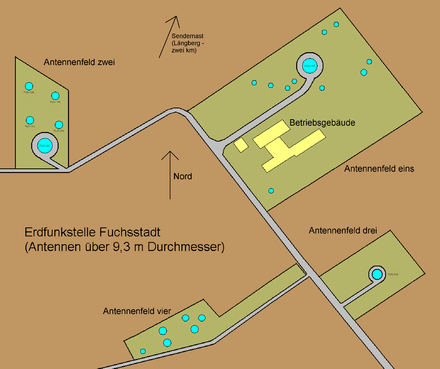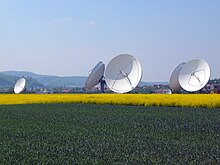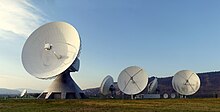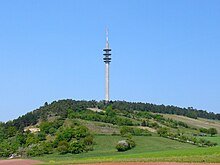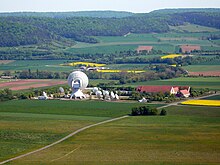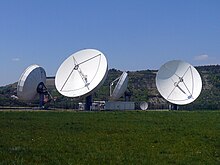Fuchsstadt earth station
The Fuchsstadt earth station is an earth station in the Lower Franconian district of Bad Kissingen in the area of the municipality of Fuchsstadt . It was built by the Deutsche Bundespost and is now operated by the US company Intelsat . The Fuchsstadt earth station serves as a ground station for communication with communications satellites and enables, among other things, satellite-supported telephone calls , Internet connections and television broadcasts. Until the 1990s, Fuchsstadt was an important hub in the global communications network; this importance has been lost because the vast majority of continental and intercontinental message exchange is now handled via fiber optic cables .
There are 50 parabolic antennas at the earth station, including two type A antennas with a diameter of 32 meters and about 25 others with more than 9.3 meters each. The earth station is thus one of the largest satellite communication systems in the world. It is Intelsat's first earth station in Europe and the largest of the six that the company operates. With its large parabolic antennas , it can be seen from afar in the Saale Valley.
location
The earth station is located between the federal motorway 7 and Hammelburg in the valley of the Franconian Saale on a flat plateau at 192 meters above sea level . The Franconian Saale, 15 meters below, flows around the plateau on three sides. To the southeast, Fuchsstadt is 1.5 kilometers away and Hammelburg is two kilometers away to the west. The area of the earth station is around 105,000 square meters and is surrounded by agricultural land as far as the Franconian Saale and Fuchsstadt. In the north and south there are ridges that extend in a west-east direction, corresponding to the main direction of the Franconian Saale. The surrounding mountains tower over the plateau of the earth station by up to 150 meters. These mountain ranges provide very good natural shielding without interfering with the main radiation directions to the satellites.
history
planning
Towards the end of the 1970s, the Deutsche Bundespost began planning to expand its two earth stations in Raisting and Usingen . Due to the rapidly increasing demand for satellite radio equipment with an annual increase of 20 to 25 percent, another earth station became necessary. When looking for a suitable location, it had to be taken into account that there were no interfering industrial objects in the vicinity, that the site was naturally shielded by surrounding hills and that there was no interference from the terrestrial radio link network. The connection to the transport network should be as inexpensive as possible, the site should be located in a largely earthquake-proof region, and environmental protection requirements also had to be taken into account. The intensive preliminary examinations took place until the spring of 1981.
In the Saale valley near Fuchsstadt, the engineers found an agriculturally used area within a loop of the Saale that had ideal conditions. The German Federal Post Office began preparations there for the construction of the facility.
construction
Already in the summer of 1983, after the planning approval and approval process had been completed, the access road and the cable ducts between the company building and the antenna locations were completed. In October 1983 the construction of the company building began, the size of which was geared towards the planned completion of the earth station with five antennas. Siemens became the general contractor for the construction. MAN was intended to be the subcontractor for the steel construction , ANT was the subcontractor for the reception equipment and the construction of the antenna systems. The concrete base for antenna one was built in April 1984 and the topping-out ceremony was held on May 24, 1984. A transmitter mast was built two kilometers northeast of the earth station . At the end of October 1984, the reflector of antenna one with a diameter of 32 meters and a weight of around 100 tons was mounted on the turnstile. It was assembled on the ground and lifted onto the antenna base with a special crane. The total height is 42 meters. In the same year, the construction of antenna two began. On July 1, 1985, antenna one was put into operation after the communications equipment had been calibrated. Antenna two followed in autumn 1985. Both antennas are largely identical to the two antennas erected in Raisting in 1981, both in terms of their external appearance and in terms of their essential technical features.
The costs for the first two antennas and the communications equipment amounted to 78 million German marks . A further 30 million marks were raised for the construction of the company building. The total cost at that time was around 120 million marks.
Initially, five class A parabolic antennas, each 32 meters in diameter, were planned, which were to be built gradually. Due to the advancing technical development, the antennas three and four were built smaller with better signal quality at the same time. Due to the closure by Deutsche Telekom in the 1990s, the fifth antenna was no longer built.
business
On July 26, 1985, the first traffic recording was made by antenna one via satellite with the Ceduna earth station in Australia . Antenna two was put into operation on November 11, 1985. On January 19, 1991, Deutsche Telekom decided to close the Fuchsstadt earth station due to alleged excess capacities in the field of satellite radio. Despite this decision, antenna three was put into operation on June 18, 1991 and antenna four on June 7, 1994, each with a mirror diameter of 18 meters. Other smaller antennas followed.
In addition to daily operations, there were several events in which the system played an important role. The USA used them for their communications during the 1991/1992 Gulf War . This was followed by satellite broadcasts of the 1998 World Cup in France , the Australian Open in tennis and the 1998 Olympic Games in Nagano .
Shutdown
In 2000, the Fuchsstadt earth station, which employed more than 40 people, was closed by Telekom. This was preceded by the collaboration between Telekom and France Télécom , which operates two earth stations in Brest and Bersenay, which means that an earth station was no longer required in Germany. The decision as to whether Raisting or Fuchsstadt should be closed ultimately fell on Fuchsstadt, as the then branch manager Walter Ral had campaigned for Raisting. After the formal shutdown, Fuchsstadt was still used for broadcasts from the Sydney Summer Olympics in 2000 . Then the earth station was switched off for good. Antenna four was dismantled and reused in the Raisting earth station.
Takeover by Intelsat
The second active phase of the earth station began on April 1, 2002 with the takeover by the Intelsat group, the second largest commercial satellite operator, which operates more than 50 satellites. The facility was inaugurated on June 3, 2002 in the presence of the Intelsat CEO. At the beginning, Intelsat employed about ten people in the earth station. There are now more than 30 employees and the trend is rising, around half of whom had previously worked for Telekom in the earth station. On March 20, 2002, the Bad Kissingen district office approved the construction of two new antennas on antenna field four.
In the first few weeks Intelsat installed new technical components. In addition, access to the underground pipeline network has been improved. In the spring of 2002, the construction of two 13-meter antennas began, which were put into operation in June. Intelsat's planning aimed from the beginning to expand the earth station in order to provide more capacity for its customers. Initially, Intelsat had received approval to expand the earth station to 15 antennas. Additional antennas were approved in the following years. The earth station could be expanded to over 40 antennas by 2009, influenced by the increasing demand for satellite communication. The new antennas have a diameter of 4.3 to 16.4 meters, but smaller ones with a diameter of up to four meters were also created. Building permits have already been obtained for a further three antennas, which can be installed if required. In July 2009, the installation of seven more antennas, four with 16.4 and three with 9.3 meters, was approved, so that the number of antennas will increase from over nine meters to over 30 after the expansion.
Operation of the earth station continued after the takeover of Intelsat in August 2004 by four private equity firms. In November 2004, a monitoring and control system for Intelsat satellites previously installed in Raisting was installed. Antenna fields one, two and four were fenced in and video-monitored. The air conditioning systems for dissipating the heat generated were increased from 14 to 150 and three additional diesel generators were installed for emergency power supply. Even under Intelsat and its successors there were and are sporting highlights such as broadcasts of the NBA , NASCAR car races and Formula 1 . Intelsat invested a total of tens of millions in the earth station.
Structure of the plant
The entire facility is divided into several areas. It consists of the company building, four antenna fields with more than 40 fully movable parabolic antennas and the transmission mast. Currently, 23 large parabolic antennas for transmitting and receiving signals to All used or from space. Intelsat has built 20 of them in the last few years, mostly of the same size (9.3, 13 and 16.4 meters in diameter). Two of the three older antennas are 32 meters in diameter and the third 18 meters. Additional antennas with a diameter of 4.2 to 6.3 meters are also used to send and receive signals. Other smaller parabolic antennas, up to four meters in size, can only be used to receive signals, most of which are from Intelsat.
The antennas over ten meters in diameter are mainly used in the frequency range of the C-band and the smaller ones, including the 9.3-meter antennas, in the Ku-band range in order to be able to communicate with the geostationary satellites from Intelsat. These satellites are located around 36,000 kilometers above sea level and serve Europe, North and South America, Africa and large parts of Asia.
Operations building
The company building consists of several interconnected building complexes in which over 30 people are employed. The company building consists of six structures, structured according to functions, and covers an area of around 7,000 square meters. Below this is the central control room, from where all important functions are monitored and operated remotely. The monitoring and control system for Intelsat satellites is housed in a specially secured part of the building.
The facade of the building was made of natural stone and provided with tile-covered gable roofs. The company building is connected to the antenna fields by cable duct systems.
Power supply
The earth station is supplied with electricity by two 20 kV lines from the Fuchsstadt substation . In order to maintain the power supply of the entire earth station in the event of a power failure, there are four stationary diesel engines in the operating building , which can be switched on separately for emergency power and uninterruptible power. Three of the four diesel sets with connected generators were installed under Intelsat. The generator from the time the earth station was built provides slightly less power .
In order to prevent the effects of voltage fluctuations from the public electricity network - for example during switchovers or thunderstorms - on sensitive parts of the electrical systems, these are protected by a protective mechanism: the energy is buffered by a flywheel weighing 2900 kilograms , which rotates at 3300 revolutions per minute turns. This flywheel generates electricity that is available to the sensitive electronic system components of the earth station.
Antenna fields
The earth station contains five antenna fields, four of which are equipped with antennas and are about 500 meters apart. The company building, which is connected to antenna field one, is located within the four antenna fields. The four antenna fields are fenced and video-monitored.
| Antennas with a diameter of more than ten meters (as of 2008) | |||||
|---|---|---|---|---|---|
| Name of the antenna |
throughput knife |
Antenna field |
Name of the antenna |
throughput knife |
Antenna field |
| FUS-01A | 32 meters | one | FUS-10A | 16.4 meters | four |
| FUS-02A | 32 meters | two | FUS-11A | 16.4 meters | two |
| FUS-03A | 18 meters | three | FUS-12A | 16.4 meters | two |
| FUS-04A | 13 meters | four | FUS-14A | 16.4 meters | two |
| FUS-05A | 13 meters | four | FUS-15A | 16.4 meters | four |
| FUS-07A | 16.4 meters | two | - | 11 meters | one |
- Antenna field 1
The antenna field 1 is the main area of the earth station. The earth station's first antenna from 1984 with a diameter of 32 meters is located here. The antenna consists of a main and a catch reflector, which are aligned with the satellite by an automatic tracking system. The antenna can withstand wind speeds of up to 180 kilometers per hour. In contrast to the somewhat older antennas in Raisting, the antenna is equipped with a new type of hyperbolically curved support for the auxiliary reflector, and the rear reflector cladding is missing. The antenna base has three levels. The central air conditioning is located on the lowest operating floor. The devices for controlling the antenna and the transmission technology are located on the other two floors. Another operating room in the steel structure of the antenna is equipped with its own air conditioning system.
Two antennas have a diameter of 16.4 meters, two more of 13 meters. There are also nine antennas with 9.3, one each with 11, 8.1, 4.6 and two with 4.2 meters in diameter. Two of these antennas are controlled by shelter boxes - containers with technology installed in them. There are also more than ten additional antennas with a diameter of up to four meters without shelter boxes.
- Antenna field 2
There is a 32-meter antenna from 1985 and four additional antennas, each 16.4 meters in diameter, as well as several smaller antennas. The 32-meter antenna is identical to the antenna on field one. The antenna, like its counterpart on field one, was repainted in 2005. The four 16.4 meter antennas are controlled by two shelter boxes located within the field.
- Antenna field 3
This antenna field contains an antenna from 1991 with a diameter of 18 meters. Another antenna with a diameter of 13 meters is planned.
- Antenna field 4
There was an antenna with a diameter of 18.3 meters and a total weight of 23 tons. This was dismantled after the shutdown and brought to Raisting. There are currently three antennas with a diameter of 16.4 meters, two with a diameter of 13 and two with a diameter of 9.3 meters. Within the antenna field there are several shelter boxes that are necessary for the operation of the antennas.
- Antenna field 5
Originally, five antenna fields, each with a 32-meter antenna, were planned. Due to the decision to close the earth station in 1991, Telekom did not build a fifth antenna. This antenna field was also taken over by Intelsat in 2002. No antennas are to be installed on this field in the future either.
- Transmission mast
The transmitter mast is located two kilometers northeast of the earth station on the Längberg (310 meters above sea level ). The transmission mast is used to broadcast radio and television , but also to direct radio-based telecommunications, such as the transmission of telephone calls, from and to the earth station in the vicinity. The height of the tower and the antenna on it is determined by the need to be able to send and receive the signals without interference over a large area.
The transmission mast is a modified type of telecommunications (FMT) 16 with four platforms but no operating floor. The tower shaft itself is 111 meters high, with the mast attached, the transmission mast has a total height of 137.5 meters. The platforms are 79, 85, 92.5 and 100 meters high. The lowest platform has a smaller diameter than the other three. There were several mirrors on the individual platforms , most of which were dismantled by Telekom after the shutdown.
Current situation
Despite the insolvency-related takeover of Intelsat, the earth station is constantly being expanded. In 2007, three more antennas with a diameter of 4.5 to 9.3 meters were installed in antenna field one. Another antenna is currently under construction. The foundation for this is ready and it contains the cables and fixings for the later antenna. The expansion of the system was often criticized by the local population, which now clearly exceeds the originally planned final expansion of 17 antennas in 2002.
radiation
The Federal Network Agency issues a certificate required for use for each antenna . In addition, separate location certificates are issued, in which it is specified where the limits of the individual antennas for the height distance to residential buildings and terrain are. A long stay within these limits can lead to health problems due to radiation exposure . Very high energies occur in the center of every antenna reflector.
Every antenna in Fuchsstadt has an elevation angle of at least eight degrees. This is to ensure a sufficient elevation to the surrounding area and the buildings. The specified safety distance in the main beam direction is 140 for antenna one, 245 for the second antenna and 236 meters for the third antenna. For antennas four and five, which were the first to be installed under Intelsat - two 13-meter antennas on antenna field four - the safety distance is 1,425 meters. The major differences in the safety distances depend on the different sizes of the antennas and the transmission power used.
criticism
In the municipal council meetings of the municipality of Fuchsstadt, compliance with the radiation values of the individual antennas was addressed, the main radiation directions of which partly point over built-up areas. Parts of the municipal council and the citizenry therefore demanded proof from the operator of the earth station that the antennas were safe. Günter Zorbach, head of the earth station and former telecommunications manager, refers to the location certificates of the Federal Network Agency, according to which the system complies with all safety standards and assures that the electromagnetic radiation emitted by the antennas does not go beyond the limits set for each antenna for humans is dangerous.
However, critics rate the fact that the antennas are set up at a minimum distance from each other due to interference, which corresponds to twice the mirror diameter, as an indication that the antennas are also exposing their immediate surroundings to radiation. Zorbach argues that this lateral distance is only necessary so that two antennas do not interfere with each other when they transmit on the same frequency. The municipality has so far failed to have the radiation exposure in the vicinity of the facility examined by neutral experts. However, it could not fully interpret the ray diagrams presented by Zorbach.
See also
Web links
- Official website of Intelsat
- Intelsat press release - October 2006 (PDF; 1.12 MB)
- Telcom Report from Siemens (PDF; 2.30 MB)
- Fuchsstadt earth station on YouTube
- Fuchsstadt earth station
Individual evidence
- ↑ Intelsat press release - October 2006 (PDF; 1.1 MB).
- ↑ a b c d The earth station at 1100 years of Fuchsstadt ( Memento from October 1, 2007 in the Internet Archive )
- ^ Telecom Report . No. 4/1985 , Fuchsstadt - a new earth station for satellite connections, p. 242 .
- ↑ Raisting earth station ( Memento of the original from June 3, 2009 in the Internet Archive ) Info: The archive link was inserted automatically and has not yet been checked. Please check the original and archive link according to the instructions and then remove this notice.
- ^ Satellites at Intelsat.com
- ↑ a b Saale Zeitung of May 16 and 17, 2002.
Coordinates: 50 ° 7 ′ 5 ″ N , 9 ° 55 ′ 25 ″ E

